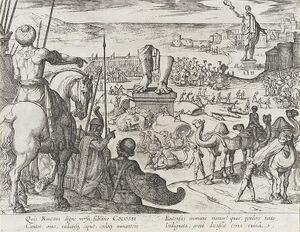Colossus of Rhodes (nonfiction): Difference between revisions
Jump to navigation
Jump to search
No edit summary |
No edit summary |
||
| Line 7: | Line 7: | ||
== In the News == | == In the News == | ||
<gallery | <gallery> | ||
File:Nysa on Maeander Library Upgrade.jpg|link=Nysa on the Maeander|[[Nysa on the Maeander]] invites the Colossus of Rhodes to visit, stay as long as it likes. | File:Nysa on Maeander Library Upgrade.jpg|link=Nysa on the Maeander|[[Nysa on the Maeander]] invites the Colossus of Rhodes to visit, stay as long as it likes. | ||
</gallery> | </gallery> | ||
Latest revision as of 18:36, 11 August 2017
The Colossus of Rhodes /roʊdz/ (Ancient Greek: ὁ Κολοσσὸς Ῥόδιος ho Kolossòs Rhódios) was a statue of the Greek titan-god of the sun Helios, erected in the city of Rhodes, on the Greek island of the same name, by Chares of Lindos in 280 BC.
One of the Seven Wonders of the Ancient World, it was constructed to celebrate Rhodes' victory over the ruler of Cyprus, Antigonus I Monophthalmus, whose son unsuccessfully besieged Rhodes in 305 BC.
Before its destruction in the earthquake of 226 BC, the Colossus of Rhodes stood over 30 metres (98 feet) high, making it one of the tallest statues of the ancient world.
In the News
Nysa on the Maeander invites the Colossus of Rhodes to visit, stay as long as it likes.
Fiction cross-reference
Nonfiction cross-reference
External links:
- Colossus of Rhodes @ wiki.karljones.com
- Colossus of Rhodes @ Wikipedia
[[Category:Statues (nonfiction)

